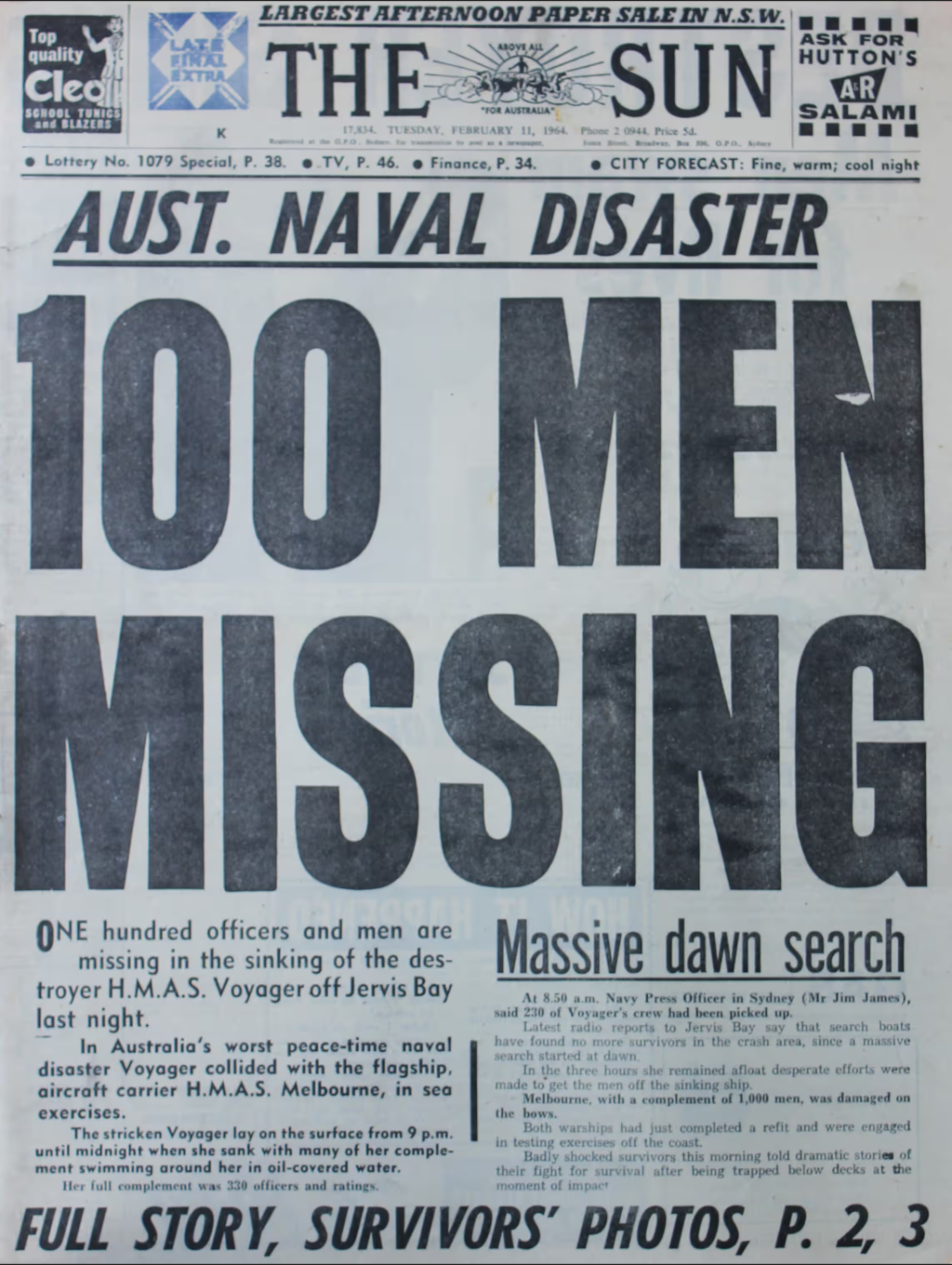On this day, 10 February 1964, 82 Australian servicemen lost their lives in the worst peace-time tragedy in the history of the Royal Australian Navy.
The RAN was conducting night flying exercises off the coast of Jervis Bay – the ‘port’ territory of the ACT located on the NSW South Coast – when the Daring Class Destroyer HMAS Voyager unexpectedly veered in front of the Aircraft Carrier HMAS Melbourne. Both ships’ captains tried frantically to correct and steer away from each other, but it was to no avail as the Melbourne collided with the Voyager, splitting the smaller destroyer in two. The Senior Officers on the Bridge were killed instantly, while others faced a desperate fight to escape before the vessel permanently dragged them under.
Lindsey Shaw of the National Maritime Museum describes how:
‘Within seconds Captain [of the Melbourne R.J.] Robertson had ordered boats into the water, nets over the side of the carrier for survivors to clamber up and helicopters into the air. In this state of confusion, darkness and panic training swung into place and true heroes were made. The bow of Voyager had heeled sharply onto its starboard side and then turned upside down. Some 60 men were in the forward cafeteria and as water poured in they tried to get out through the escape hatches – but some wouldn’t open. The senior sailor of Voyager was Jonathan ‘Buck’ Rogers and he took control of the situation, sending sailors to hatches that would open and trying to open the jammed ones. When he realised that it was too late he was heard leading the men in prayer. The bow section sank completely in just under 10 minutes. Meanwhile the aft section stayed afloat, sinking slowly, until just after midnight.’
The next day a distraught Prime Minister Menzies promised a swift investigation, releasing a statement saying:
‘It is a shocking disaster unparalleled in the peace-time history of Australia. The Government and the Naval Board extend their very deep sympathy to the bereaved families who have sustained so sudden and tragic a loss.
I want to announce at once that there will be a prompt and thorough investigation into this tragedy. I have decided that the normal machinery for Naval investigations is inadequate for the present purposes. There will therefore be a full public investigation conducted by a judge. I cannot, of course, yet say who the judge will be. I will also discuss with my colleagues whether he should be assisted by Naval experts acting as assessors. But the main thing I want to make clear at this early stage is that the investigation is to be prompt, thorough, public and conducted by a judge.’
The calling of a Royal Commission broke all existing precedent with how RAN matters were handled, but such was the gravity of the disaster that in the end there would be two Royal Commissions. The first was held over 50 days in 1964, and concluded that the Voyager was at fault but also laid out some controversial criticisms of the Melbourne’s leading officers. In response, the greatly insulted Captain R.J. Robertson resigned from the Navy.
On hearing reports of evidence not raised during the commission that the Voyager’s Captain had consumed a triple brandy shortly before the collision, a group of Liberal backbenchers began campaigning for a new inquiry which might exonerate Robertson. By this time Menzies had retired, and a ‘dramatic parliamentary debate’ in May 1967 prompted his successor Harold Holt to conduct a new Royal Commission – once again breaking new ground in being the first time two Royal Commissions had been held over the same incident. Conducted over 85 days, ‘every aspect of the Navy’s corporate culture’ was analysed and assessed. In the end the Commission determined the sole cause of the collision lay with the Voyager and that no blame could be attached to any person serving onboard the Melbourne.
Even after the passing of decades, debate surrounding the causes of the tragedy still rages, and the event has cast a long shadow over the RAN. Compensation claims lodged by families faced frustrating and protracted fight, with a Hight Court ruling blocking such claims in 1965 before being overturned in 1982. Some legal proceedings lasted until as recently as 2017.
Further Reading:
Tom Frame, Where Fate Calls: The HMAS Voyager Tragedy (Sydney: Hodder & Stoughton, 1992)
Tom Frame, ‘Breaking Ranks or Distorting the Record?: Debate over the HMAS Voyager Tragedy Continues’, The Sydney Institute Quarterly, Issue 27, Vol. 9, No. 4, January, 2006.
Sign up to our newsletter
Sign up for our monthly newsletter to hear the latest news and receive information about upcoming events.


